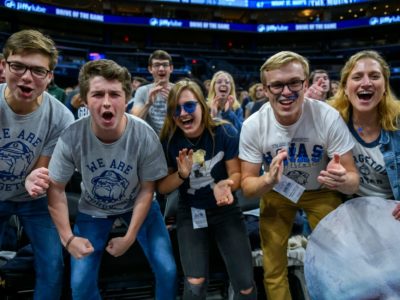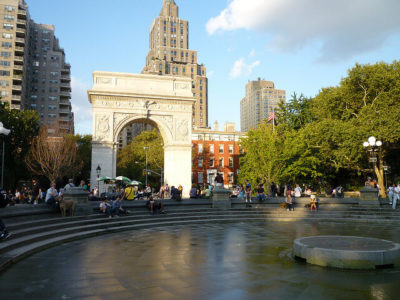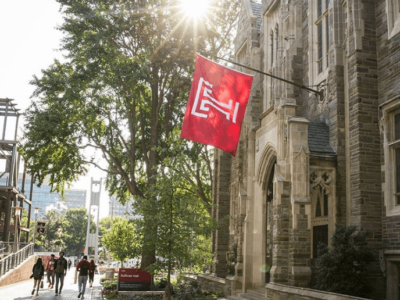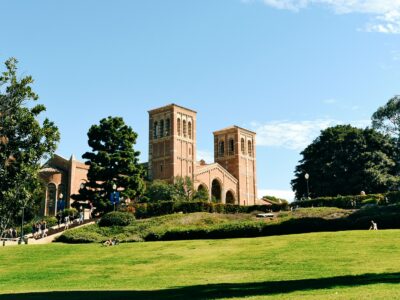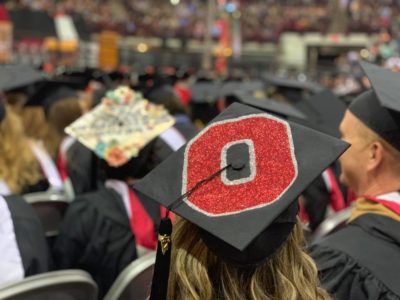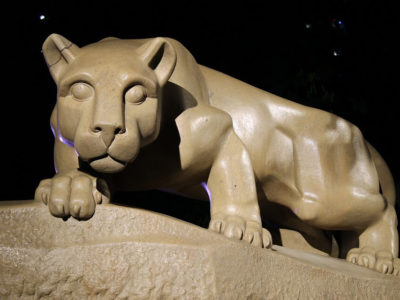Does being close to the Capitol send a shiver of excitement down your spine? Could you spend 72 hours straight exploring the Smithsonian? Do you picture yourself sitting at your own glossy wooden government desk, replete with American flags and a flashy gold nametag? If you’re itching to learn in the varied and diverse area of Washington, D.C., look no further. From large research universities with unbeatable school spirit to small liberal arts colleges known for their personalized experiences, D.C. for every interest, talent and educational type out there.
Read on for the top 10 colleges near Washington, D.C.
10. Randolph-Macon College
https://www.facebook.com/RandolphMacon/photos/a.10151338805305183/10163314172835183/?type=3&theater
While D.C. is a bustling and complex area, the surrounding area is rich with colleges that feel like home. Enter Randolph-Macon College, right in the vicinity of Richmond, Virginia. With a student enrollment of less than 1,500 and student to faculty ratio of 11:1, this college provides students with a well-rounded and personalized liberal arts education. Students choose either an arts or science degree and then take a variety of different courses throughout different “areas of knowledge.” Another plus? Randolph-Macon has a unique academic calendar with a fall and spring semester of four months each, allowing students to use the month of January for various different off-campus educational opportunities. Previous students have traveled to the Galapagos Islands to study evolution and conservation, traced the histories of Henry VIII’s wives on-site in England and interned at nearby labs and hospitals. On top of that, RMC offers the EDGE Career center, a personalized career preparation plan that provides students with one-on-one career counseling throughout their college experiences. For a small institution, it still maintains a full athletic department: The Randolph-Macon Yellow Jackets compete Division III in a wide range of sports, including a football team whose legendary games with Hampden-Sydney College are dubbed the “Oldest Small-College Rivalry in the South.”
9. McDaniel College
https://www.facebook.com/McDanielCollege/photos/a.326292144099071/3125633820831542/?type=3&theater
Just because McDaniel’s campus population clocks in at a cozy 1,500 doesn’t mean it lacks the academic and athletic opportunities of larger schools in the area. With 12% of students majoring in physical education in 2018, McDaniel’s balances the sports-heavy culture of a larger university with the atmosphere of a tight-knit liberal arts college. The campus sits in Westminster, Maryland, a suburb of Baltimore with the opportunity for the occasional trip into D.C. The academic “McDaniel plan” allows students to specialize in the area of their major while still gaining a wide knowledge of other subjects. McDaniel also has a second campus in Budapest, Hungary where students come from around the world to study business, poli sci, communication, psychology and art. Thanks to the “Weekend Blitz,” a program organized by McDaniel student life, trip costs to cool events in Baltimore, Philadelphia, and D.C., like going to a sports game, museum amusement park, are subsidized. The McDaniel campus is also its own bustling center, featuring events like the annual Rubber Duck Hunt and Pumpkin Hunt, both organized by the aptly named “Green Terror Programs.” On the field, McDaniel’s first football game dates back to 1891, and since then has seen icons like quarterback Eugene “Stoney” Willis and running back Bill Shepherd. No wonder they’re nicknamed the “Green Terror.” ”
8. Catholic University of America
Sitting in northeast D.C.’s Brookland neighborhood, Catholic University of America maintains the small, close-knit feel of a religious liberal arts college. The familiar and easygoing community owes to the fact that a full 95% of the student body lives on campus. The student to faculty ratio is an impressive 7:1, so students can be sure that they can form close and supportive relationships with professors and advisors alike. Catholic U students can personally attest to the benefits of small numbers. “I think it depends on how many classes you’re taking and their level of difficulty, but I’d say in general you have to be very responsible, attentive and patient,” said sophomore Kaylin Hunzicker. “If you are falling, there’s lots of resources available.” Catholic U offers a wide array of scholarships, awarding excellence in academics, leadership and more. They even offer scholarships for music performance, local church parishioners and those admitted as seminarians. In terms of academics, Catholic U delivers a liberal arts-style curriculum, allowing students to pursue multiple areas of interest and disciplines of study, including architecture, mechanical engineering and political science. Catholic U also possesses the country’s only ecclesiastical faculty of canon law, a program to prepare students for priesthood. Students at the School of Canon Law can earn their doctorate in canon law or even get a master’s in church administration. For students really looking to get that hands-on experience, the school provides a unique opportunity to study onsite in Rome at the Vatican.
7. Howard University
Ready to learn at the Mecca? Affectionately given this nickname by students and locals alike, Howard University is a historically black university on D.C.’s east side. HU offers both a rich student culture and opportunities for involvement in the ongoing research projects by faculty on campus. A walk around the campus offers a step back in time, featuring multiple historical sites like the Fredrick Douglass Memorial Hall, which dates back to its dedication in 1935. Howard also offers the only dental school in D.C. as well as four different honors programs and societies, divided into Arts and Sciences, Business Executive Leadership, Communications and Education. Honors students have access to their own study abroad opportunities, exclusive networking contacts and a designated honors advisor. Howard has also launched multiple initiatives to increase minority representation in the STEM fields, including an on-campus program initiated by Google. Through the initiative, now known as Tech Exchange, classes are taught with the addition of a Google engineer as an adjunct professor. Students have traveled to Google’s headquarters for an onsite internship experience. The International Pals program helps to make Howard University a “home away from home” for all its students from abroad by educating the campus on the diverse cultures that make up its student population.
6. George Mason University
As one of the most active educational institutions in ongoing research in the nation, this Fairfax, Virginia university boasts two Nobel prize-winning graduates. Students at George Mason University have the life-changing opportunity to participate in research alongside professors and get hands-on experience in the field of their choosing. GMU’s state-funded endowment means that students can study at the forefront of almost any discipline they want, including their famous economics and law departments, as well as the popular majors of public health, criminal justice and psychology. Five hundred student organizations call GMU home, including multiple on-campus publications, Greek life and the Mason Player’s Performing Arts Society. The on-campus Eaglebank arena seats 1,000 and has hosted concerts with such big names as Demi Lovato, Panic! At the Disco, Mac Miller, and the Beastie Boys. “Mason is for anyone and there’s something for everyone!” said junior Rebecca Durant. “We have so many extracurriculars as well, including Greek Life, sports, academic clubs, social clubs, etc. Everyone has a niche and when we come together as one, it’s such a great community that anyone can belong to!” GMU also has plenty of opportunities for students to get involved in the administration. More than 50 university committees have student representatives. The Student Government also organizes an annual January trip taking over 100 students, alumni, faculty and staff to the Richmond Capitol building to lobby for higher education.
5. George Washington University
To the urban D.C. enthusiasts desperate to stay close to the action, George Washington University is the iconic political powerhouse. Located near the capitol, GWU draws students looking for a research university with a rigorous curriculum. GWU received a charter from the government in 1821, and its convenient location gives easy access to the D.C. central hub. Given its spotlight reputation in the city, GWU holds numerous events of international notoriety every year, including presidential debates and the World Bank and IMF annual meeting. That said, the prestigious institution offers much more than just political connections. The on-campus Multicultural Student Services Center serves as a safe space for students from different cultural backgrounds, facilitates “Real Conversations,” a cultural education program and organizes events to celebrate cultural heritage. “I chose GW for diversity of cultures where students come from different cultures and backgrounds that I wanted to explore through my peers compared to studying abroad or traveling,” said senior William Davis. GWU interacts closely with its surrounding community, with its own hospital and location a quick half-hour walk from the Watergate Hotel and the John F. Kennedy Center for the Performing Arts, which offers Broadway-standard shows like Hamilton and Hello Dolly, and other performances every day of the week. And while GW’s address near the center of D.C. gives it a firm political voice, there’s plenty of room for the less politically-minded. Think of GW’s political side as an open opportunity for those interested, like any other extracurricular. The central thing that unites GW students: drive. “I have not once met a person who has no idea of what they would like to achieve their goals or even how to,” Davis said. “Everyone has a sharp mind and tries to work with others at some point throughout college to help conquer each other dreams.” If you’re looking for a student community that supports your personal passions and goals, check out GW.
4. American University
For those who doubt that American University lives up to its impressive hype, prepare to be proven wrong. With faculty like Rep. Jamie Raskin, Ralph Nader and the former first lady of Egypt, Jehan Sadat, you can be sure that American’s famous political science, international relations and communications programs live up to the hype. Situated next to the US Department of Homeland Security and a half-hour commute to the National Mall, AU is just close enough to have access to the political core without being overwhelmed by it. For those so inclined, it’s also in possession of a vibrant Greek life community. Don’t expect your average exclusionary frats and sororities: AU’s Greek life organizations include GUIDE (an initiative to improve diversity and inclusion), a Greek Wellness Coalition and an Intercultural Greek collective that oversees eight different culture-based organizations. AU has an impressive career center with a 99% rate of satisfaction among students. The center runs multiple programs to assist students and alumni in the job hunt, like job search support groups, “site visit day,” in which small groups of students are sent to employer offices to explore careers, and “Mock Interview Madness,” an annual event in early March in which recruiters and hiring managers stage practice interviews with students. For those trade policy nerds and compulsive New York Times readers, this could make the top of your list, but if you’re avoiding an office job, AU has something for you too: AU has the second largest number of Peace Corps volunteers among medium-sized American universities. Students looking to volunteer can work with nonprofits like the National Gay and Lesbian Chamber of Commerce, the Feminist Majority Foundation and Refugees International through AU’s on-campus Center for Community Engagement and Service.
3. University of Maryland College Park
If you spent all of high school aching to join a large, colorful and thriving college student body, check out University of Maryland College Park’s community of 41,000 students. This public research university is a half-hour drive from D.C., but with such a multifaceted and exciting campus environment, the University is a student town unto itself. “Even though this is only my second semester here, I love the camaraderie of the campus! Everyone is so happy to be a TERP and I love the fellowship,” said sophomore Ronan Bogley. With 127 undergraduate degrees and 112 graduate degrees, any conceivable interest or career path will find its own like-minded corner at UMD. These degrees range from Agricultural and Resource Economics to Supply Chain Management to Early Childhood Education. Students can also elect to live with others pursuing the same major, so the atmosphere is ripe to meet your own tribe. ”I feel like anyone can come to UMD and feel like they belong,” said senior Leslie Vega. Junior Aziz Khan agreed. “The community is accepting and makes you feel at home,” he said. Athletes and sports enthusiasts gravitate towards UMC for its 20 sponsored varsity teams that compete in Division I and collectively hold 44 national championships. “The school also offers a wide range of extracurriculars and student clubs and societies: I am currently involved with the Catholic Terps, but would like to be involved with many more groups on campus,” Bogley said. “The Catholic Terps are a very welcoming community and a few of my friends from home are a part of it!” Whether you’re in for the sports scene or the unique degree paths, UMD has something to offer everyone.
2. Johns Hopkins University
A university of many locations, Johns Hopkins extends through three campuses: one an hour outside of D.C. in Baltimore, Maryland and two others in Italy and China. Its high public reputation is due to classes, professors and workload designed to be challenging and push students to their full potential. Luckily, Johns Hopkins also offers a rich and vibrant student culture complete with a wide variety of clubs and social events, like the Allnighters, a male a capella group, the Magical Arts Initiative for aspiring magicians and the Buttered Niblets, an improv comedy troupe. The advisory, career center and on-campus resources support students throughout all their endeavors, both academic and otherwise. For the musically inclined, JHU offers the Peabody Institute, the oldest conservatory in America, that puts on over 50 events open to the public every year and organizes 30 different a capella and dance groups, a chamber ensemble, gospel choir, wind ensemble and jazz bands. JHU is also home to an impressive cast of professors: Woodrow Wilson, author and theorist John Barth and Nobel Laureate biochemist Peter Agre have all taught classes. And with a 7:1 faculty ratio, students get more access to professors and advisers. Johns Hopkins earns its name from its excellent medical programs at the Bloomberg School of Public Health, including a Master of Bioethics and Population Health Management degree.
1. Georgetown University
Despite its location in the tres-chic shopping neighborhood of the same name, Georgetown’s campus would make Albus Dumbledore feel right at home. The college’s mission mixes a traditional educational institution with a commitment to push students to be the best they can, both inside and out of the classroom. While Georgetown earns its reputation for its world-class international relations and political science departments, students with a diverse variety of interests find a home here. The unmatched opportunities offered to students include unique study abroad experiences and even internships on Capitol Hill. Students have access to opportunities like studying social transformation in Cape Town, South Africa, tutoring local elementary school children with the D.C. Reads program and working alongside defense attorneys. Three GU law students even helped free a wrongfully convicted man in 2018. With a 16.8% acceptance rate and reputation for intense academic rigor, expect to be challenged. But don’t be intimidated: professors still maintain an intimate and welcoming environment in classes. “The classes are very small, and it gets you to really interact with the people around you and make close connections with your professors, which will help you in the long run,” said Leah Skanda, a sophomore. “Or, if you just need extra help in class, you don’t feel intimidated by what’s going on.” Thanks to the on-campus Academic Resource Center, students have access to individualized academic support, like tutoring, workshops and disability services.

